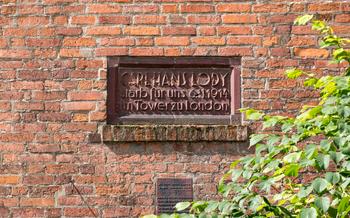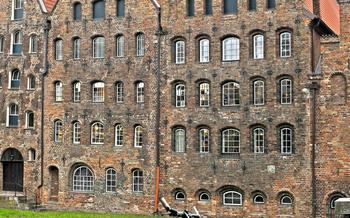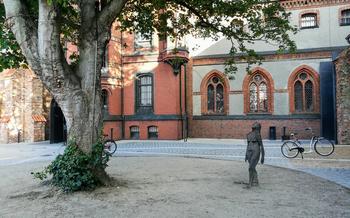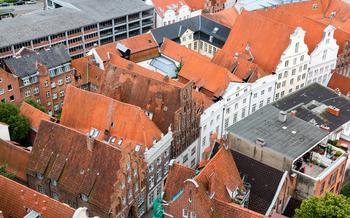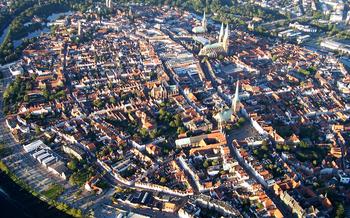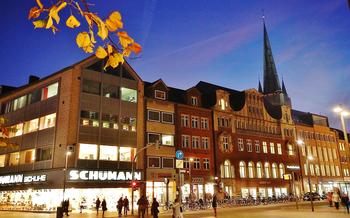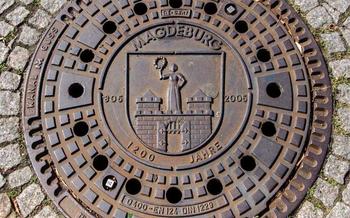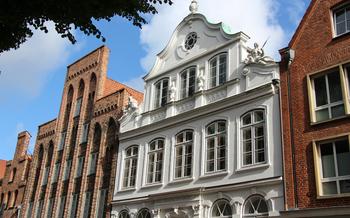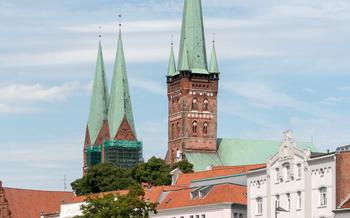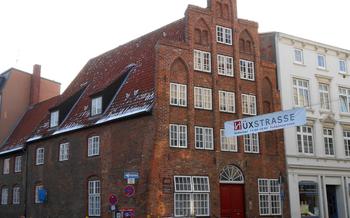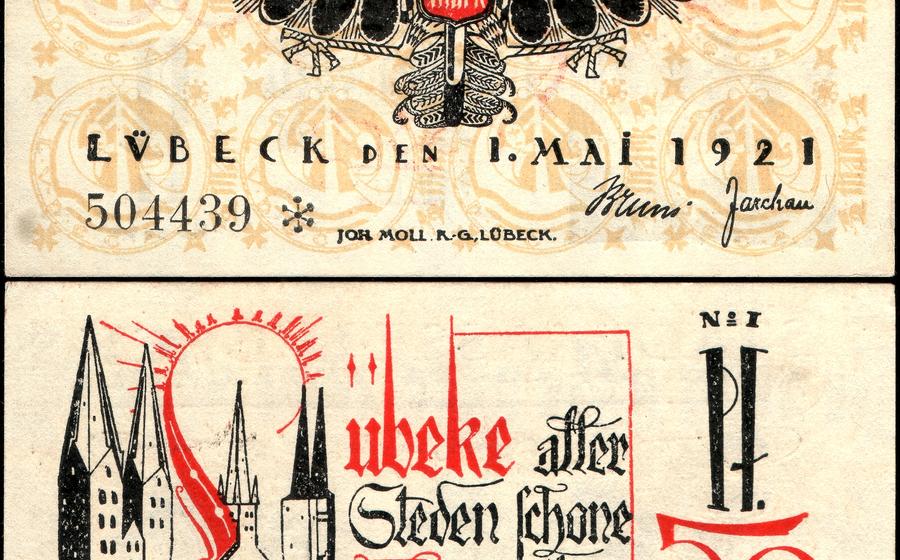
Altstadt (Lübeck Old Town)
- Lübeck Old Town: A UNESCO World Heritage Site
- Strolling the Cobblestone Streets
- Holstentor: The Iconic City Gate
- St. Mary's Church: A Gothic Masterpiece
- Lübeck Cathedral: A Symbol of Power
- Town Hall: A Seat of Power
- Museum Behnhaus Drägerhaus: Art and History
- European Hansemuseum: Exploring the Hanseatic League
- St. Anne's Museum: Medieval Art and Crafts
- Buddenbrookhaus: A Literary Landmark
- Burgtor: A Fortified Gateway
- Shopping in Lübeck
- Culinary Delights of Lübeck
- Lübeck Christmas Market: A Festive Experience
- Insider Tip: Off the Beaten Path
Lübeck Old Town: A UNESCO World Heritage Site
Lübeck's Old Town, a captivating realm of history, architecture, and culture, has earned its well-deserved place as a UNESCO World Heritage Site. Step into this enchanting enclave, where the past comes alive amidst cobblestone streets and majestic buildings. Lübeck's rich legacy unfolds as you wander through its Altstadt, where every corner whispers tales of the Hanseatic League's grandeur and the city's pivotal role in shaping the course of history.
The architectural wonders of the Old Town are a testament to Lübeck's prowess as a maritime powerhouse. Gothic churches, adorned with intricate spires, stand tall against the backdrop of centuries-old merchant houses, their facades adorned with exquisite carvings and gabled roofs. This harmonious blend of architectural styles creates a cityscape that is both awe-inspiring and enchanting.
Lübeck's cultural heritage is deeply intertwined with its maritime past. The city's museums, galleries, and churches are treasure troves of art, artifacts, and stories that shed light on Lübeck's pivotal role in the Hanseatic League. From paintings depicting the bustling harbor to intricate ship models, each exhibit offers a glimpse into the vibrant world of trade and commerce that once defined this city.
A visit to Lübeck's Old Town is a pilgrimage into the heart of German history and culture. Immerse yourself in the city's unique charm, explore its hidden corners, and discover the treasures that await you in every nook and cranny. Lübeck's Altstadt is not just a UNESCO World Heritage Site; it's a living testament to the power of history, architecture, and culture.
Strolling the Cobblestone Streets
Lübeck's cobblestone streets are a delight to explore, inviting you to wander through time and discover hidden corners that whisper tales of the past. As you amble along, marvel at the intricate facades of centuries-old buildings that line the narrow alleyways, each with its own story to tell.
Duck into a cozy café or shop tucked away in a secluded courtyard, where you can savor a cup of coffee or browse for unique souvenirs. Immerse yourself in the ambiance of this enchanting city, where the gentle sound of footsteps echoes through the streets, creating a magical symphony that transports you to another era.
Strolling through Lübeck's Old Town is like stepping into a living history book. With every turn, you'll encounter historical landmarks that speak to the city's rich past. From the towering spires of St. Mary's Church to the imposing walls of the Holstentor city gate, each monument stands as a testament to Lübeck's enduring legacy.
Whether you're a history buff, an architecture enthusiast, or simply someone who appreciates the charm of a well-preserved medieval city, Lübeck's cobblestone streets offer an unforgettable experience. So put on your walking shoes and prepare to lose yourself in the labyrinthine alleys of this enchanting UNESCO World Heritage Site.
Holstentor: The Iconic City Gate
Lübeck's skyline is incomplete without the imposing figure of Holstentor, an iconic city gate that has become synonymous with the city's identity. A masterpiece of 15th-century architecture, Holstentor stands as a testament to Lübeck's glorious past as a member of the Hanseatic League. Its twin towers, adorned with intricate brickwork and topped with copper spires, create a striking silhouette against the backdrop of the city.
The gate's strategic location, once guarding the city's eastern entrance, speaks to its historical significance. Holstentor has witnessed the rise and fall of empires, the ebb and flow of trade, and the tumultuous events that have shaped Lübeck's destiny. It has stood resilient through sieges, wars, and the passage of time, remaining an enduring symbol of the city's strength and resilience.
Beyond its historical significance, Holstentor is an architectural marvel. Its intricate brickwork, with its alternating patterns and decorative elements, showcases the exceptional craftsmanship of the era. The gate's twin towers, each topped with a distinctive copper spire, create a harmonious balance and visual interest. The overall effect is one of grandeur and elegance, making Holstentor a must-see attraction for any visitor to Lübeck.
St. Mary's Church: A Gothic Masterpiece
Lübeck's skyline is dominated by the awe-inspiring St. Mary's Church, a magnificent Gothic masterpiece that stands as a testament to the city's rich history and architectural prowess. The church's construction began in the 13th century and spanned several decades, resulting in a harmonious blend of architectural styles that reflect the evolution of Gothic architecture.
The exterior of St. Mary's Church is a sight to behold, with its intricate carvings, towering spires, and flying buttresses that lend a sense of grandeur and lightness to the structure. The main entrance, adorned with elaborate sculptures, invites visitors into a world of artistic wonders.
Inside, the church's vast interior unfolds, revealing an impressive array of vaulted ceilings, graceful columns, and stained-glass windows that bathe the space in a kaleidoscope of colors. The intricate details of the carvings, the vibrant hues of the stained glass, and the sheer scale of the space create an atmosphere of awe and reverence.
St. Mary's Church is not just an architectural marvel but also a repository of significant historical events. It was here that the Treaty of Lübeck was signed in 1629, marking the end of the Thirty Years' War. The church has also played a crucial role in the city's religious and cultural life, hosting important ceremonies and events throughout the centuries.
For visitors to Lübeck, St. Mary's Church is an absolute must-see. Its stunning architecture, impressive interior, and historical significance make it a highlight of any visit to this beautiful city. Whether you're a history buff, an architecture enthusiast, or simply someone who appreciates beauty, St. Mary's Church is sure to leave a lasting impression.
Lübeck Cathedral: A Symbol of Power
Lübeck Cathedral stands as a testament to the city's rich history and religious heritage. Its imposing Gothic architecture, with its soaring spires and intricate stone carvings, dominates the skyline of Lübeck's Altstadt. Constructed over several centuries, the cathedral showcases a blend of architectural styles, from Romanesque to Gothic, reflecting the city's evolving history.
Inside the cathedral, visitors are captivated by its stunning stained-glass windows, which depict scenes from the Bible and the lives of saints. The intricate details and vibrant colors of the windows create a breathtaking spectacle of light and artistry, illuminating the vast interior space.
As a symbol of Lübeck's power and influence, the cathedral played a significant role in the city's religious and political life. It served as the seat of the Prince-Bishopric of Lübeck, which ruled over the city and surrounding territories for centuries. The cathedral's grandeur reflects the wealth and prestige of the city during the Hanseatic League era, when Lübeck was one of the most important trading centers in Northern Europe.
Today, Lübeck Cathedral remains an active place of worship and a popular tourist attraction. Its historical significance, stunning architecture, and impressive interior make it a must-see landmark for anyone visiting Lübeck. Whether you're a history buff, an architecture enthusiast, or simply seeking spiritual inspiration, the cathedral offers a profound and awe-inspiring experience.
Town Hall: A Seat of Power
Lübeck's Town Hall stands as a symbol of the city's rich history, power, and prosperity. Constructed in the 13th century, this Gothic masterpiece has served as the seat of local government for centuries. Its grand facade, adorned with intricate carvings and sculptures, reflects the city's importance as a major trading hub during the Hanseatic League.
Inside, the Town Hall boasts an impressive array of grand halls and chambers, each with its own unique history and significance. The Great Hall, with its high vaulted ceilings and stained-glass windows, is a particularly awe-inspiring sight. Here, the city's council members have met for centuries to discuss and make decisions that have shaped the course of Lübeck's development.
Beyond its historical significance, the Town Hall is also a testament to the city's architectural prowess. Its intricate details and harmonious blend of Gothic and Renaissance styles make it a masterpiece of medieval architecture. Visitors can admire the building's exterior from the cobblestone square, or take a guided tour to explore its opulent interior.
As a must-see attraction in Lübeck, the Town Hall offers a glimpse into the city's rich past and its enduring legacy as a center of power and prosperity. Whether you're a history buff, an architecture enthusiast, or simply someone who appreciates beautiful buildings, this iconic landmark is sure to leave a lasting impression.
Museum Behnhaus Drägerhaus: Art and History
The Museum Behnhaus Drägerhaus is an unmissable destination for art and history enthusiasts visiting Lübeck's Old Town. Housed in a magnificent 18th-century building, the museum showcases an extensive collection of paintings, sculptures, and decorative arts from the Middle Ages to the present day.
A Journey Through Art and History
As you wander through the museum's galleries, you'll embark on a journey through Lübeck's rich artistic and historical heritage. The collection includes works by renowned local and international artists, providing a glimpse into the city's vibrant cultural scene throughout the centuries.
Historical Artifacts
In addition to its impressive art collection, the museum also houses a significant collection of historical artifacts. These artifacts offer a fascinating glimpse into Lübeck's past, from its days as a powerful Hanseatic city to its role as a major cultural and economic center in the region.
Cultural Significance
The Museum Behnhaus Drägerhaus is not just a repository of art and history; it is also a place where culture comes alive. The museum regularly hosts exhibitions, workshops, and events that celebrate Lübeck's rich cultural heritage and foster a sense of community among art enthusiasts.
A Must-Visit for Art Enthusiasts
Whether you're an art aficionado or simply someone who appreciates beautiful things, the Museum Behnhaus Drägerhaus is a must-visit destination in Lübeck. Its diverse collection, stunning architecture, and engaging exhibitions will leave you inspired and enriched.
European Hansemuseum: Exploring the Hanseatic League
Step into the fascinating world of the Hanseatic League at the European Hansemuseum in Lübeck. This interactive museum brings the history and significance of this powerful medieval trading alliance to life. Through engaging exhibits, multimedia presentations, and hands-on displays, visitors can explore the rise and fall of the Hanseatic League, its impact on trade and commerce, and its lasting legacy on European history.
Gain insights into the daily lives of Hanseatic merchants, their trading routes, and the challenges they faced. Discover the secrets of their success and the reasons for their eventual decline. Learn about the Hanseatic League's role in shaping the political, economic, and cultural landscape of Northern Europe.
The European Hansemuseum is a must-visit for anyone interested in history, trade, and the Hanseatic League. With its interactive exhibits and immersive displays, the museum offers a captivating and educational experience for visitors of all ages.
Insider tip: The museum offers guided tours in English and German, providing visitors with a deeper understanding of the Hanseatic League and its significance.
St. Anne's Museum: Medieval Art and Crafts
St. Anne's Museum is a treasure trove of medieval art and history, housed in a former monastery dating back to the 13th century. Its collection boasts an impressive array of medieval paintings, sculptures, and decorative arts that offer a fascinating glimpse into the artistic and cultural heritage of Lübeck.
As you wander through the museum's dimly lit halls, you'll be transported back in time to the Middle Ages. Admire the intricate details of the carved wooden altarpieces, depicting scenes from the Bible and the lives of saints. Marvel at the delicate beauty of the gold and silver reliquaries, adorned with precious stones and intricate filigree work.
Among the museum's highlights is the "Totentanz" (Dance of Death), a series of 15th-century paintings that depict the inevitability of death for all, regardless of social status or wealth. These poignant and thought-provoking works offer a glimpse into the medieval fascination with mortality and the afterlife.
St. Anne's Museum is a must-visit for anyone interested in medieval art and history. Its collection provides a unique opportunity to explore the artistic and cultural achievements of this fascinating period.
Buddenbrookhaus: A Literary Landmark
Lübeck's literary heritage shines brightly at the Buddenbrookhaus, the birthplace of Nobel laureate Thomas Mann. This historic building, steeped in literary history, offers visitors a unique glimpse into the life and works of one of Germany's most celebrated authors.
The Buddenbrookhaus takes its name from Mann's renowned novel, "Buddenbrooks: The Decline of a Family," which chronicles the rise and fall of a wealthy merchant family in Lübeck. The novel, a masterpiece of German literature, draws heavily on Mann's own family history and the city's rich mercantile past.
Visiting the Buddenbrookhaus is a must for literature enthusiasts. The museum offers a fascinating journey through Mann's life and work, showcasing his writing desk, personal belongings, and first editions of his novels. Visitors can also learn about the Buddenbrook family and the social and cultural context that shaped Mann's writing.
The Buddenbrookhaus is not just a museum; it's a place where literature comes alive. Regular readings, exhibitions, and events bring Mann's work to life, allowing visitors to connect with his characters and stories on a deeper level.
Whether you're a fan of Thomas Mann or simply enjoy exploring literary landmarks, the Buddenbrookhaus is a must-visit destination in Lübeck. This historic building offers a unique and immersive experience that will transport you to the world of one of Germany's most celebrated authors.
Burgtor: A Fortified Gateway
Among the many fascinating landmarks that grace Lübeck's cityscape, the Burgtor stands out as a testament to the city's rich history and architectural prowess. This fortified gateway, erected in the 15th century, served as a crucial defensive structure, protecting the city from potential invaders. Its imposing presence, adorned with intricate brickwork and decorative turrets, speaks volumes about Lübeck's past as a powerful Hanseatic city.
As you approach the Burgtor, you can't help but be struck by its sheer size and grandeur. The gate's robust construction, featuring two massive towers flanking a central archway, exudes an aura of strength and resilience. Intricate carvings and decorative elements adorn the gate's façade, showcasing the exceptional craftsmanship of the medieval builders.
Step through the archway and you'll find yourself in a charming courtyard, where you can soak in the ambiance of this historic site. The courtyard is surrounded by beautifully preserved buildings, some of which date back to the Middle Ages. Take a moment to admire the architectural details, including the elegant gables, ornate doorways, and intricate brickwork that characterize these structures.
The Burgtor not only served as a defensive structure but also played a significant role in Lübeck's trade and commerce. As a gateway to the city, it witnessed the arrival and departure of merchants and goods from all corners of the Hanseatic League. The gate's strategic location allowed Lübeck to control access to the city and protect its valuable trade routes.
Today, the Burgtor stands as a proud symbol of Lübeck's rich history and cultural heritage. It's a must-see attraction for anyone interested in exploring the city's medieval past. As you stand beneath its imposing archway, you can't help but feel a sense of awe and wonder at the resilience and ingenuity of those who built this magnificent structure.
Shopping in Lübeck
Shopping in Lübeck is a delightful experience that combines the charm of traditional boutiques with the excitement of modern shopping malls. From unique handicrafts and antiques to designer clothing and jewelry, Lübeck offers a diverse range of shopping options to suit every taste and budget.
Strolling through the cobblestone streets of the Altstadt (Old Town), you'll find an array of independent boutiques nestled amidst historical buildings. These charming shops offer a treasure trove of unique items, including handcrafted ceramics, hand-blown glass, and traditional Lübeck souvenirs.
For those seeking a more modern shopping experience, Lübeck also boasts several shopping malls and department stores. The Lohmühle Shopping Center, located in the heart of the city, is home to over 100 stores, including international brands and local boutiques. The Kaufhof department store, another popular shopping destination, offers a wide range of products from fashion and accessories to electronics and home goods.
Lübeck is also known for its antique shops, which are scattered throughout the city. Here, you can find everything from vintage furniture and jewelry to rare books and collectibles. Whether you're a seasoned collector or simply enjoy browsing for unique treasures, Lübeck's antique shops are sure to delight.
So, whether you're looking for a special gift, a unique souvenir, or simply a day of retail therapy, Lübeck is the perfect place to indulge in some shopping.
Culinary Delights of Lübeck
Lübeck's culinary scene is a harmonious blend of traditional dishes, local specialties, and fresh, seasonal ingredients. Indulge in the delightful flavors of the region and savor the unique culinary experiences that Lübeck offers.
Don't miss the opportunity to try the Lübecker National, a traditional dish consisting of roast pork, dumplings, red cabbage, and a sweet-sour sauce. Another must-try is Marzipan, a sweet treat made from almonds, sugar, and rose water, which originated in Lübeck in the 15th century.
For a taste of local specialties, visit one of the many charming cafes or restaurants in the city. Sample Labskaus, a hearty dish made from corned beef, potatoes, and beetroot, or try Rote Grütze, a refreshing dessert made from red berries and served with cream or vanilla sauce.
Lübeck is also known for its excellent seafood, thanks to its proximity to the Baltic Sea. Enjoy freshly caught fish, such as cod, herring, or salmon, prepared in a variety of ways. Don't forget to pair your meal with a glass of local beer or wine to enhance the culinary experience.
For those with a sweet tooth, Lübeck offers a variety of confectionery shops and cafes. Indulge in delicious cakes, pastries, and chocolates, all made with local ingredients and traditional recipes.
Whether you prefer traditional dishes, local specialties, or international cuisine, Lübeck's culinary scene has something to offer everyone. Embark on a culinary journey and discover the unique flavors of this charming city.
Lübeck Christmas Market: A Festive Experience
As the festive season approaches, Lübeck transforms into a magical winter wonderland, with the annual Christmas market taking center stage. The streets are adorned with twinkling lights and charming decorations, creating an enchanting atmosphere that captivates visitors from near and far.
The market, held in the heart of the Altstadt, features an array of wooden stalls showcasing unique gifts, traditional crafts, and delectable treats. From hand-blown glass ornaments and intricately carved wooden toys to mouthwatering gingerbread and steaming mugs of mulled wine, there's something for everyone to enjoy.
Strolling through the market, visitors can soak in the festive cheer while browsing the stalls and indulging in the delicious offerings. The air is filled with the scent of roasted almonds, cinnamon, and freshly baked pastries, creating an irresistible sensory experience.
For a truly memorable experience, visitors can take a ride on the nostalgic carousel, marvel at the enchanting light displays, or simply soak in the festive ambiance while enjoying a traditional German Christmas carol.
Whether you're seeking unique gifts, savoring culinary delights, or simply embracing the magic of the season, the Lübeck Christmas Market is an unforgettable experience that should not be missed.
Insider Tip: Off the Beaten Path
While exploring the main attractions of Lübeck Old Town is a must, venturing off the beaten path can lead to some hidden gems. One such gem is the St. Jakobi Church, located in the heart of the old town. This beautiful Gothic church boasts stunning architecture, a peaceful ambiance, and a rich history. Another hidden treasure is the Museum of Nature and the Environment, which offers a fascinating glimpse into the natural world of the region.
For a unique cultural experience, visit the Theater Lübeck, which stages a variety of performances throughout the year, from classic plays to contemporary productions. And if you're looking for a relaxing escape, head to the Wakenitz River, where you can take a leisurely boat tour or enjoy a peaceful walk along the scenic riverbanks.
These hidden gems offer a glimpse into the lesser-known side of Lübeck, providing a more authentic and immersive experience for visitors. Whether you're interested in history, nature, culture, or simply exploring the unknown, Lübeck has something to offer everyone.
